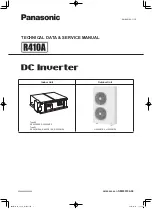
3
INSTALLATION AND OPERATING INSTRUCTIONS
Power Source Requirements
The power source must provide a nominal voltage of 12.5 volts DC and must be able
to supply the necessary current to operate the load. The power source may be a
battery or a well-regulated DC power supply. To obtain a rough estimate of the current
(in amperes) the power source must deliver, simply divide the power consumption of
the load (in watts AC) by 10.
Example: If a load is rated at 500 watts AC, the power source must be able to deliver:
500 divided by 10 = 50 amperes
CAUTION
The Power Inverter must be connected only to batteries with a nominal
output voltage of 12 volts. The unit will not operate from a 6 volt
battery and will sustain permanent damage if connected to a 24 volt
battery.
Connection to Power Source
The Power Inverter comes equipped with a DC accessory outlet plug and battery clip
cables for connection to a power source.
Connecting to a Power Source Using the Accessory Outlet Plug
The DC accessory outlet plug is suitable for operating the inverter at power outputs up
to 100 watts. The tip of the plug is POSITIVE (+) and the side contact is NEGATIVE (–).
Connect the inverter to the power source by inserting the DC accessory outlet plug
firmly into the accessory outlet of a vehicle or other DC power source.
CAUTIONS
• Connect directly to power source when operating above 100 watts.
• Do not use with positive ground electrical systems.
• Reverse polarity connection will result in a blown fuse and may
cause permanent damage to the inverter.
Notes:
Most vehicle accessory outlet circuits have fuses rated at 15 to 20 amps or
greater. To operate at full wattage, either use the battery clip cable (supplied)
or directly wire to the power source with user-supplied wire and fuse.
The majority of modern automobiles, RVs and trucks are negative ground.
Connecting to a Power Source Using the Provided Cables
Use the provided cables and connect the Power Inverter directly to the 12 volt power
source as follows:
1. Make sure the Power Inverter power is turned OFF and that no flammable fumes
are present in the installation area.
2. Connect the RED cable to the RED post marked (+) on the back of the inverter.
Connect the battery clip to the POSITIVE terminal of the battery.
3. Connect the BLACK cable to the BLACK post marked (–) on the back of the
inverter. Connect the battery clip to the NEGATIVE terminal of the battery.
4. Make sure that all connections between battery clips and terminals are secure.
2
The DC-to-DC converter stage uses modern high frequency power conversion
techniques that have replaced the bulky transformers found in less technologically-
advanced models. The inverter stage uses advanced power MOSFET transistors in a
full bridge configuration. This ensures excellent overload capacity and the ability to
operate reactive loads, such as lamp ballasts and small induction motors.
The Power Inverter Output Waveform
The AC output waveform of the Power Inverter is known as “modified sine wave.” It
is a waveform that has characteristics similar to the sine wave shape of utility power.
This type of waveform is suitable for most AC loads, including linear and switching
power supplies used in electronic equipment, transformers, and motors.
The modified sine wave produced by the Power Inverter has an RMS (root mean
square) voltage of 120 volts, which is the same as standard household power. Most
AC voltmeters (both digital and analog) are sensitive to the average value of the
waveform rather than the RMS value. They are calibrated for RMS voltage under the
assumption that the waveform measured will be a pure sine wave. These meters will
not read the RMS voltage of a modified sine wave correctly. They will read about 20
to 30 volts low when measuring the output of the inverter. For accurate measurement
of the output voltage of this unit, use a true RMS reading voltmeter such as a Fluke
87, Fluke 8060A, Fluke 77/99 series, Beckman 4410, or Triplett 4200.
Modified Sine Wave and Sine Wave Comparison
PROTECTIVE FEATURES OF THE INVERTER
The Power Inverter monitors the following potentially hazardous conditions:
Low Battery Voltage — This condition is not harmful to the inverter, but could damage
the power source. The Power Inverter automatically shuts down when input voltage
drops to 10.5 volts ± .3 volt. When the condition is corrected, the inverter should be
turned off, then turned back on.
Over Voltage Protection — The Power Inverter will automatically shutdown when the
input voltage exceeds 15.5 volts DC ± .5 volt DC.
Ground Fault Protection — The Power Inverter will automatically shutdown when
ground leakage current is detected.
Short Circuit Protection — Reverse polarity or short circuit condition may cause
external or internal fuses to open and may cause irreversible damage to the Power
Inverter. Take extra care to ensure a proper polarity hook-up.
Overload Protection — The unit will automatically shut down when the continuous
draw exceeds the unit’s rated output. Reduce load and manually reset using the
inverter’s ON/OFF switch.
Over Temperature Protection — If the temperature inside the Power Inverter is too
high, the unit will automatically shut down. Allow the unit to cool for at least 15
minutes before restarting after a heat-related shutdown. Unplug unit while cooling.
PI500CP_ManualEN_010807 1/8/07 4:48 PM Page 2
























